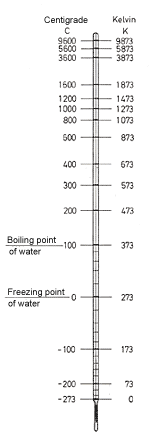Electromagnetic radiation
The total range of this radiation can be divided into radio waves, radar waves, heat rays, light rays, ultraviolet rays, X-rays and Gamma rays. All these rays obey the same laws despite the fact that they appear very different to human sensing systems and that technology requires the most various devices to master them. Electromagnetic waves can also spread in a vacuum. They are then at the same speed for all frequencies.
Light
Electromagnetic radiation of varying intensity and wave-length capable of causing an impression of brightness and color in the human eye. Most
light sources radiate mixed light, consisting of different light colors. The wave-length is used in optics to characterize these colors.
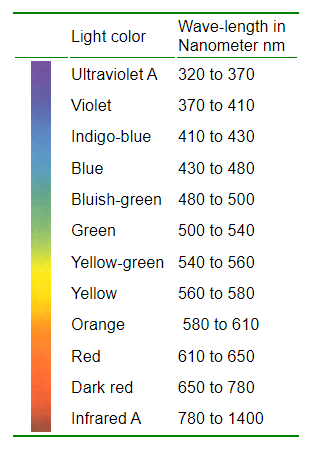
Table 1: Spectral colors
Light energy increases as wave-length decreases. Blue light has more energy than red light. The nature of light has not yet been explained exactly. The best explanation has been offered by the quantum theory: "Light consists of particles which often behave like a wave." Light as defined by photography is all radiation between 320 and 1050 nm. Outside these wave-lengths, special equipment such as quartz lenses and photon amplifiers necessary in order to create pictures.
Color
Color is the psychological response of the eye to electromagnetic radiation between 380 and 780 nm. Color sensing is operated via three different sensing systems for blue, green and red. Color film, color selection techniques and color television are based on the way the eye sees color for their theoretical construction.
Color chart
The color chart is a system based on standard light types and on the average human color feeling, allowing accurate placing of a color on a graph by means of numerical values. For better orientation, the light colors have been added in Fig. 1 as in the curve diagrams.
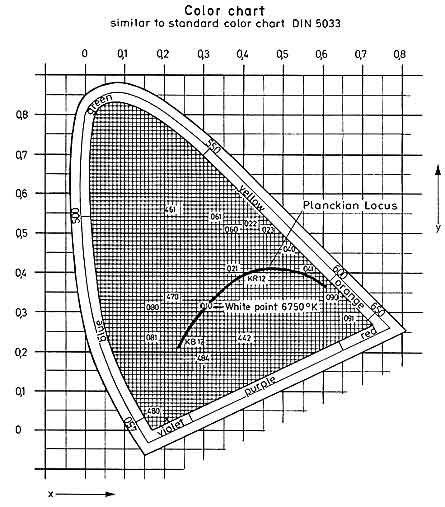
Fig. 1: Color chart
Special attention should be paid to the "Planckian locus" on which all points of the color triangle from the temperature radiators are plotted. The colors of the
conversion filter also have to lie on the curve or in its immediate vicinity. Fig. 2 shows a section of the Planckian locus.
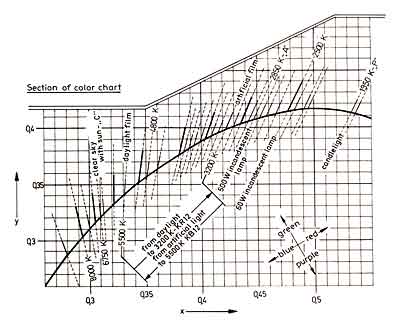
Fig. 2: Section of color chart: Planckian locus
Here we have deviated from the standard form on order to clarify those relations of special imprtance to color photography. The technique of shifting light balance can be taken from the note ( from daylight to 3200 K => KR 12 and from artificial light to 5500 K => KB 12 ).
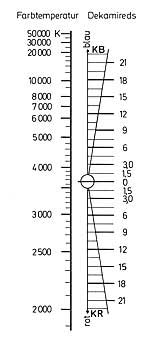
Fig. 3: Color temperature and filter value
In Fig. 3 the color temperature curve has been extended and reduced to pure mathematical values. Both scales can be shifted like a slide rule to determine thickness of filter. The distance of the color temperatures on the left-hand scale correspond to the distance of the filter values on the right-hand scale.
As mentioned above, the color chart in Fig. 1 is the exact mathematical expression of normal human color feeling. Via the subjective sensitivity of the eye to the blue, green and red areas, it is possible to fix the "location of the color" on a net of coordinates for values of x and y. The outer edge of the color triangle ( finely-shaded area ) is the location of the highest possible saturation of each color. Approximately in the center of the triangle where the colorless ultraviolet haze filter is situated, is the achromatic point. The data presented on the color chart is based on light with a color temperature of 6700 K ( clear sky with sun ). The achromatic point lies on the curve of the temperature of a light source increases, the achromatic point moves towards blue; if color temperature is decreased, the achromatic point moves towards red.
Fig. 2 shows a section of this curve. The general color locations are given in the form of a wind rose to facilitate orientation. A few types of light are marked by lines, the achromatic point of each color temperature is located at the intersection point with the curve. The lines mark colors most similar to the respective color temperature.
It is clear that the filter scale ( Fig. 3 ) is based on Figs. 1 and 2. Blue and red are designated as in Table 1. Zero point of the decamired scale can be adjusted to each temperature like a slide rule. The filter thickness necessary for conversion can be directly read off. The decamired value of each filter can be added for combinations, for example, KR 3 + KR 6 = KR 9.
Color temperature
The temperature in degrees Centigrade, increased by 273 degrees ( the 273 degrees represent the distance from the zero of the centigrade thermometer, the freezing point of water to the lowest possible temperature, absolute zero). Temperature is given in Kelvin. The calibrations of the thermometer are not altered. The Kelvin temperature scale is the basis of the color temperature. The color temperature again is a measure for the color description of a temperature radiator.
As an example: A hot cooking plate at 200°C has a color temperature of 273 degree + 200 degree = 473 Kelvin ( the abbreviation of Kelvin is K ). Maximum radiation lies at 6000 nm in the infrared area of the spectrum. The receptor of this heat radiation is our skin which responds to electromactnetic radiation with the signals cold, cool, warm or hot. If our heat sense signals hot, as in the case of the cooking plate, one is able to produce a thermal photography by means of infrared.
At temperatures of over 800-000 K, the eye begins to register the radiation. First of all, purely red, at 2000-3000 K yellow, and lastly at 10,000 K blue color impressions.
